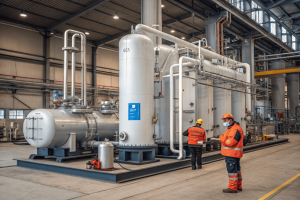What type of industries can use CO₂ recovery equipment?
•
What type of industries can use CO₂ recovery equipment?
Are you watching a pure stream of CO₂ vent from your facility? This wastes a valuable resource and increases your carbon footprint when a simple, effective solution is readily available.
CO₂ recovery equipment is ideal for industries that produce a concentrated stream of carbon dioxide. Prime examples include breweries, distilleries, ethanol plants, biogas upgrading facilities, and ammonia production plants, which can all capture and reuse their CO₂.

As an engineer at FTL Machine, I've seen firsthand how versatile this technology is. It’s not just for one type of factory. Any process that creates a relatively clean and concentrated flow of CO₂ is a perfect candidate for recovery. The key is turning a waste byproduct into a valuable asset, and many different sectors can achieve this. Let's explore which ones are best suited for this technology.
Which industries use carbon capture?
You see a lot of talk about carbon capture at huge power plants. This makes you wonder if the technology is even practical for your own operation, which might be much smaller.
Industries that use carbon capture are typically those producing a high-concentration CO₂ stream as a natural byproduct. Breweries, ethanol producers, and biogas facilities are prime examples, as capturing their CO₂ is far more efficient than from a diluted source.

The secret to successful CO₂ recovery is the concentration of the source gas. It's a simple matter of economics and efficiency. The less "other stuff" you have to separate the CO₂ from, the easier and cheaper the process becomes. This is why our systems are so popular in industries where the CO₂ is practically pure right from the start.
High-Concentration vs. Low-Concentration Sources
I always explain to clients that not all CO₂ streams are created equal. The viability of a recovery project depends heavily on the source.
| Industry | CO₂ Source | CO₂ Concentration | Viability for Recovery (with our tech) |
|---|---|---|---|
| Brewery / Distillery | Fermentation | >99% | Excellent |
| Ethanol Plant | Fermentation | >99% | Excellent |
| Biogas Upgrading | Raw Biogas Separation | 40-50% | Good |
| Ammonia Plant | Syngas Production | >98% | Excellent |
| Cement Plant | Kiln Flue Gas | 15-25% | Requires different, more complex tech |
Our equipment excels in those top categories. It's designed to take a rich stream of CO₂ and polish it into a high-purity liquid, making it a perfect fit for the fermentation and biogas industries.
What are the industrial uses of CO2?
You have successfully captured your CO₂. But what can you actually do with it? Storing a tank of liquid CO₂ doesn't seem very useful unless you have a plan for it.
Captured CO₂ has many industrial uses. The most common are carbonating beverages, food processing and packaging (MAP), water treatment, welding as a shielding gas, and stimulating plant growth in greenhouses. It is also a raw material for producing chemicals.

This is where the circular economy really comes to life. The CO₂ that was once a waste product becomes a valuable commodity, either for your own processes or to be sold to others. I worked with a large craft brewery that used to vent all of its fermentation CO₂. Now, they capture it, use what they need for carbonation, and sell the high-purity liquid surplus to a local company that packages lettuce. They turned a cost center into a new revenue stream.
From Byproduct to Valuable Resource
The applications for recovered CO₂ are surprisingly diverse. It's a versatile gas with unique properties that make it essential in many different sectors.
| Application Area | Specific Use | Why CO₂ is Used |
|---|---|---|
| Food & Beverage | Beverage Carbonation | Creates "fizz" and acts as a mild preservative. |
| Food Processing | Modified Atmosphere Packaging | Displaces oxygen to extend the shelf life of food. |
| Welding & Metal Fab | Shielding Gas | Prevents the molten weld from reacting with the air. |
| Agriculture | Greenhouse Enrichment | Increases the rate of photosynthesis, boosting yield. |
| Water Treatment | pH Control | Safely lowers the pH of alkaline water. |
| Chemical Industry | Feedstock | A building block for urea fertilizer and polymers. |
What industries release carbon dioxide?
You know that CO₂ emissions are a global issue. But it's often hard to pinpoint exactly where they all come from, beyond the obvious culprits like cars and power stations.
While power generation and transportation are the largest sources, nearly all heavy industries release carbon dioxide. This includes cement manufacturing, steel production, and chemical plants. Fermentation industries also release biologically sourced, high-purity CO₂.

It is important to distinguish between the different types of CO₂ sources. The exhaust from a coal-fired power plant is very different from the CO₂ coming off a fermentation tank. While both are CO₂, their concentrations and the impurities mixed in with them are worlds apart. This distinction is critical when we talk about recovery.
Combustion vs. Process Emissions
We can group CO₂ sources into two main categories:
- Combustion Emissions: This is CO₂ created by burning fossil fuels like coal, oil, and natural gas. The CO₂ is mixed with nitrogen from the air and various other pollutants like sulfur oxides (SOx) and nitrogen oxides (NOx). This makes it a "dirty" or low-concentration stream that is difficult to capture. Industries like power generation, cement, and steel are major sources of combustion emissions.
- Process Emissions: This is CO₂ created as a direct byproduct of a chemical or biological process, not from burning fuel for heat. The fermentation that brewers and ethanol plants use is a perfect example. This CO₂ is often a very pure, high-concentration stream. These are the "low-hanging fruit" for CO₂ recovery because they require minimal cleanup before liquefaction.
Our focus at FTL Machine is on capturing these clean process emissions, providing an efficient and economical solution for these specific industries.
Conclusion
Many industries, especially in the beverage, biofuel, and biogas sectors, can use CO₂ recovery equipment. They can capture their pure process emissions and turn a waste stream into a valuable asset.
You may also be interested in:

Why is CO₂ recovery technology gaining popularity worldwide?
Why is CO₂ recovery technology gaining popularity worldwide? You see headlines about carbon capture everywhere. But you wonder if it's
Read more
How is a CO₂ recovery system designed to fit different industries?
How is a CO₂ recovery system designed to fit different industries? You're under pressure to implement a CO₂ recovery solution.
Read more
How energy-efficient are today’s CO₂ recovery technologies?
How energy-efficient are today’s CO₂ recovery technologies? You want to recover CO₂, but you fear that high electricity bills will
Read more